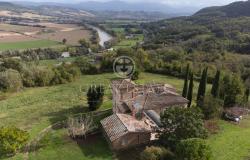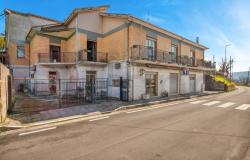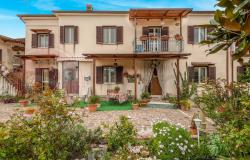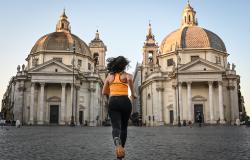 The beautiful painted walls of two dining rooms in which the Emperor Nero may once have had supper have gone on show in Rome as part of a major new exhibition of Roman frescoes preserved by the eruption of Vesuvius in 79 AD.
The beautiful painted walls of two dining rooms in which the Emperor Nero may once have had supper have gone on show in Rome as part of a major new exhibition of Roman frescoes preserved by the eruption of Vesuvius in 79 AD.
Nero's dining rooms, or triclinia, were found under a thick layer of volcanic ash by builders at Moregine, a suburb of Naples, during work on the Naples-Salerno motorway in 2000 and have been reconstructed in their original dimensions for the show at Rome's Palazzo Massimo alle Terme.
The wall paintings feature the emperor dressed as Apollo accompanied by Muses and are thought to have belonged to a house completed in 64 AD as an imperial inn for Nero during his trips along the coast.
Around 100 fresco panels from the collection of the National Archaeological Museum of Naples are also on display here, all detached from walls at the Vesuvian towns of Pompeii, Herculaneum, Stabiae and Boscotrecase during the first archaeological excavations of the area in the 18th century.
While the house at Moregine may have had a more generous budget than most, Rome's archaeology chief Angelo Bottini pointed out at the show's inauguration that many of the frescoes on display came from more humble homes.
''Pompeii was a small town with almost no members of the senior classes or senators,'' Bottini said.
''Nevertheless its painting is one of the things that has made it famous because such a large quantity of frescoes - preserved in breathtaking quality in entire rooms, entire towns - has not survived in Rome''.
According to art historian Eric Moormann, who contributed to the exhibition catalogue, the desire to decorate walls with images of mythological figures and gardens reflecting an ideal, fairy-tale world would have been common to all social classes.
''The decorative systems basically underlined an idea of social well-being which we find today in magazines such as Beautiful Home and Schoner Wohnen,'' said Moormann.
''But even though Roman frescoes seem a sort of wallpaper, they constantly astonish us with their variety of forms, composition, themes and multicoloured palette,'' he added.
Panels on show here have been arranged according to the themes of mythology and religious rites, landscapes and still lifes, portraits, scenes from the theatre and pure decoration, providing a comprehensive survey of wall painting in the region between the first century BC and the first century AD.
Many of the frescoes feature the costly Pompeian red, an intense colour obtained from finely ground cinnabar, or mercuric sulphide, and a distinctive marker of painting in the Vesuvian towns.
Among the highlights of the exhibition are the Arimaspe and the Griffin (60-50 BC) from the Villa of Mysteries in Pompeii, showing a legendary inhabitant of northern Scythia in eastern clothing fighting off a huge beaked griffin whose wings extend to their full length; and a portrait of Theseus from the Basilica of Herculaneum (45-79 AD) with grateful children clinging to the limbs of the hero fresh from his defeat of the Minotaur.
Also reconstructed in its entirety is a stunning garden fresco found in Pompeii's House of the Gold Bracelet, named because the skeleton of a woman wearing a gold bracelet was found in one of its rooms.
The floor-to-ceiling painting, which may have decorated a small office, shows a garden thick with green shrubs and trees such as oleanders, viburnums and strawberry trees, while swallows, magpies, turtle doves and nightingales perch in the foliage around a gushing fountain.
Palazzo Massimo alle Terme's permanent collection includes some of the few surviving frescoes painted in Rome in the same period at the Villa di Livia, Villa della Farnesina and Villa di Castel di Guido.
''This exhibition offers visitors a rare opportunity to admire wall painting from Rome and Campania under the same roof,'' Bottini said.
'Pompeian Red - Pictorial Decoration in the Collections of the National Museum of Naples and at Pompeii' runs at the Museo Nazionale Romano di Palazzo Massimo alle Terme in Rome until March 30 2008.













